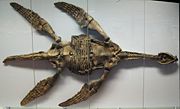
Posidonia Shale
Encyclopedia
The Posidonia Shale is a Lower Jurassic
geological formation famous for its exceptionally well-preserved complete skeletons of fossil marine fish and reptiles. The Posidonienschiefer as German paleontologists call it, takes its name from the ubiquitous fossils of Posidonia bronni that characterize its fauna. The formation comprises finely laminated layers of bituminous shale
s formed of fine-grained sediments intercalated with bituminous limestones and crops out in a number of locations in southwestern Germany, although most famously near the village of Holzmaden
. The Europe
an bituminous shales deposited on a sea floor during the Early Toarcian
in the ancient Tethys Ocean
are described as being deposited in an anoxic, or oxygen depleted, deep water environment, although the details of the depositional environment are the subject of debate by researchers of the formation.
In addition to their Posidonia bronni, the shales contain some spectacularly detailed fossils of other Jurassic sea creatures—ichthyosaur
s and plesiosaur
s, spiral-shelled ammonite
s and crinoid
s, or sea-lilies.
Early Jurassic
The Early Jurassic epoch is the earliest of three epochs of the Jurassic period...
geological formation famous for its exceptionally well-preserved complete skeletons of fossil marine fish and reptiles. The Posidonienschiefer as German paleontologists call it, takes its name from the ubiquitous fossils of Posidonia bronni that characterize its fauna. The formation comprises finely laminated layers of bituminous shale
Bituminous shale
Bituminous shale is an argillaceous shale impregnated with bitumen, often accompanying coal. It may contain kerogen; in that case it is classified as oil shale. When carbonaceous material is present in large amounts, bituminous shale grades into bituminous coal...
s formed of fine-grained sediments intercalated with bituminous limestones and crops out in a number of locations in southwestern Germany, although most famously near the village of Holzmaden
Holzmaden
Holzmaden is a town in Baden-Württemberg, Germany that lies between Stuttgart and Ulm.The ground in and around the city contains rich layers of well preserved fossils of the Jurassic period. The fossils are found in the 160 million year old Posidonia Shale and displayed in the local Museum Hauff...
. The Europe
Europe
Europe is, by convention, one of the world's seven continents. Comprising the westernmost peninsula of Eurasia, Europe is generally 'divided' from Asia to its east by the watershed divides of the Ural and Caucasus Mountains, the Ural River, the Caspian and Black Seas, and the waterways connecting...
an bituminous shales deposited on a sea floor during the Early Toarcian
Toarcian
The Toarcian is, in the ICS' geologic timescale, an age or stage in the Early or Lower Jurassic. It spans the time between 183.0 Ma and 175.6 Ma...
in the ancient Tethys Ocean
Tethys Ocean
The Tethys Ocean was an ocean that existed between the continents of Gondwana and Laurasia during the Mesozoic era before the opening of the Indian Ocean.-Modern theory:...
are described as being deposited in an anoxic, or oxygen depleted, deep water environment, although the details of the depositional environment are the subject of debate by researchers of the formation.
In addition to their Posidonia bronni, the shales contain some spectacularly detailed fossils of other Jurassic sea creatures—ichthyosaur
Ichthyosaur
Ichthyosaurs were giant marine reptiles that resembled fish and dolphins...
s and plesiosaur
Plesiosaur
Plesiosauroidea is an extinct clade of carnivorous plesiosaur marine reptiles. Plesiosauroids, are known from the Jurassic and Cretaceous Periods...
s, spiral-shelled ammonite
Ammonite
Ammonite, as a zoological or paleontological term, refers to any member of the Ammonoidea an extinct subclass within the Molluscan class Cephalopoda which are more closely related to living coleoids Ammonite, as a zoological or paleontological term, refers to any member of the Ammonoidea an extinct...
s and crinoid
Crinoid
Crinoids are marine animals that make up the class Crinoidea of the echinoderms . Crinoidea comes from the Greek word krinon, "a lily", and eidos, "form". They live both in shallow water and in depths as great as 6,000 meters. Sea lilies refer to the crinoids which, in their adult form, are...
s, or sea-lilies.
Plesiosaurs
| Plesiosaur Plesiosaur Plesiosauroidea is an extinct clade of carnivorous plesiosaur marine reptiles. Plesiosauroids, are known from the Jurassic and Cretaceous Periods... s of the Posidonia Shale |
||||
|---|---|---|---|---|
| Taxa | Presence | Notes | Images | |
Genus:
|
|
 |
||
Pterosaurs
| Pterosaur Pterosaur Pterosaurs were flying reptiles of the clade or order Pterosauria. They existed from the late Triassic to the end of the Cretaceous Period . Pterosaurs are the earliest vertebrates known to have evolved powered flight... s of the Posidonia Shale |
||||
|---|---|---|---|---|
| Taxa | Presence | Notes | Images | |
Genus:
|
|
  |
||
Genus:
|
|
|||

